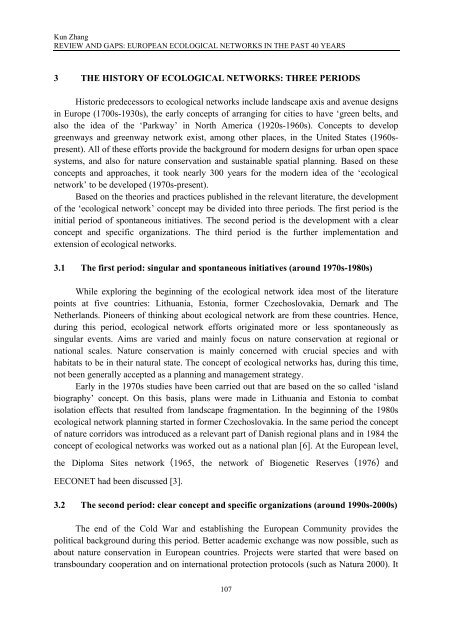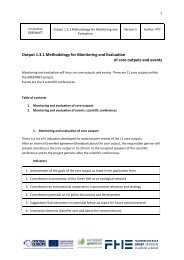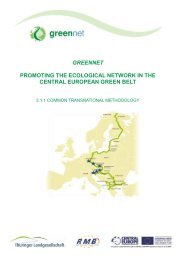The Green Belt as a European Ecological Network strengths and gaps
The Green Belt as a European Ecological Network strengths and gaps
The Green Belt as a European Ecological Network strengths and gaps
You also want an ePaper? Increase the reach of your titles
YUMPU automatically turns print PDFs into web optimized ePapers that Google loves.
Kun Zhang<br />
REVIEW AND GAPS: EUROPEAN ECOLOGICAL NETWORKS IN THE PAST 40 YEARS<br />
3 THE HISTORY OF ECOLOGICAL NETWORKS: THREE PERIODS<br />
Historic predecessors to ecological networks include l<strong>and</strong>scape axis <strong>and</strong> avenue designs<br />
in Europe (1700s-1930s), the early concepts of arranging for cities to have ‘green belts, <strong>and</strong><br />
also the idea of the ‘Parkway’ in North America (1920s-1960s). Concepts to develop<br />
greenways <strong>and</strong> greenway network exist, among other places, in the United States (1960spresent).<br />
All of these efforts provide the background for modern designs for urban open space<br />
systems, <strong>and</strong> also for nature conservation <strong>and</strong> sustainable spatial planning. B<strong>as</strong>ed on these<br />
concepts <strong>and</strong> approaches, it took nearly 300 years for the modern idea of the ‘ecological<br />
network’ to be developed (1970s-present).<br />
B<strong>as</strong>ed on the theories <strong>and</strong> practices published in the relevant literature, the development<br />
of the ‘ecological network’ concept may be divided into three periods. <strong>The</strong> first period is the<br />
initial period of spontaneous initiatives. <strong>The</strong> second period is the development with a clear<br />
concept <strong>and</strong> specific organizations. <strong>The</strong> third period is the further implementation <strong>and</strong><br />
extension of ecological networks.<br />
3.1 <strong>The</strong> first period: singular <strong>and</strong> spontaneous initiatives (around 1970s-1980s)<br />
While exploring the beginning of the ecological network idea most of the literature<br />
points at five countries: Lithuania, Estonia, former Czechoslovakia, Demark <strong>and</strong> <strong>The</strong><br />
Netherl<strong>and</strong>s. Pioneers of thinking about ecological network are from these countries. Hence,<br />
during this period, ecological network efforts originated more or less spontaneously <strong>as</strong><br />
singular events. Aims are varied <strong>and</strong> mainly focus on nature conservation at regional or<br />
national scales. Nature conservation is mainly concerned with crucial species <strong>and</strong> with<br />
habitats to be in their natural state. <strong>The</strong> concept of ecological networks h<strong>as</strong>, during this time,<br />
not been generally accepted <strong>as</strong> a planning <strong>and</strong> management strategy.<br />
Early in the 1970s studies have been carried out that are b<strong>as</strong>ed on the so called ‘isl<strong>and</strong><br />
biography’ concept. On this b<strong>as</strong>is, plans were made in Lithuania <strong>and</strong> Estonia to combat<br />
isolation effects that resulted from l<strong>and</strong>scape fragmentation. In the beginning of the 1980s<br />
ecological network planning started in former Czechoslovakia. In the same period the concept<br />
of nature corridors w<strong>as</strong> introduced <strong>as</strong> a relevant part of Danish regional plans <strong>and</strong> in 1984 the<br />
concept of ecological networks w<strong>as</strong> worked out <strong>as</strong> a national plan [6]. At the <strong>European</strong> level,<br />
the Diploma Sites network(1965, the network of Biogenetic Reserves(1976)<strong>and</strong><br />
EECONET had been discussed [3].<br />
3.2 <strong>The</strong> second period: clear concept <strong>and</strong> specific organizations (around 1990s-2000s)<br />
<strong>The</strong> end of the Cold War <strong>and</strong> establishing the <strong>European</strong> Community provides the<br />
political background during this period. Better academic exchange w<strong>as</strong> now possible, such <strong>as</strong><br />
about nature conservation in <strong>European</strong> countries. Projects were started that were b<strong>as</strong>ed on<br />
transboundary cooperation <strong>and</strong> on international protection protocols (such <strong>as</strong> Natura 2000). It<br />
107




